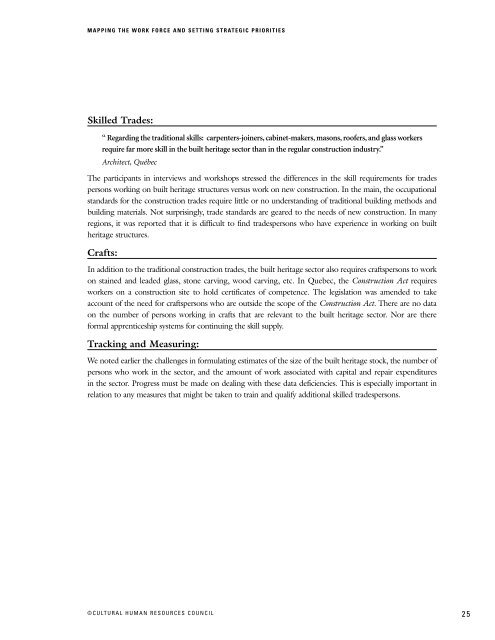MAPPING THE WORK FORCE AND SETTING STRATEGIC PRIORITIESSkilled Trades:“ Regard<strong>in</strong>g <strong>the</strong> traditional skills: carpenters-jo<strong>in</strong>ers, cab<strong>in</strong>et-makers, masons, roofers, and glass workersrequire far more skill <strong>in</strong> <strong>the</strong> built heritage sector than <strong>in</strong> <strong>the</strong> regular construction <strong>in</strong>dustry.”Architect, QuébecThe participants <strong>in</strong> <strong>in</strong>terviews and workshops stressed <strong>the</strong> differences <strong>in</strong> <strong>the</strong> skill requirements for tradespersons work<strong>in</strong>g on built heritage structures versus work on new construction. In <strong>the</strong> ma<strong>in</strong>, <strong>the</strong> occupationalstandards for <strong>the</strong> construction trades require little or no understand<strong>in</strong>g of traditional build<strong>in</strong>g methods andbuild<strong>in</strong>g materials. Not surpris<strong>in</strong>gly, trade standards are geared to <strong>the</strong> needs of new construction. In manyregions, it was reported that it is difficult to f<strong>in</strong>d tradespersons who have experience <strong>in</strong> work<strong>in</strong>g on buil<strong>the</strong>ritage structures.Crafts:In addition to <strong>the</strong> traditional construction trades, <strong>the</strong> built heritage sector also requires craftspersons to workon sta<strong>in</strong>ed and leaded glass, stone carv<strong>in</strong>g, wood carv<strong>in</strong>g, etc. In Quebec, <strong>the</strong> Construction Act requiresworkers on a construction site to hold certificates of competence. The legislation was amended to takeaccount of <strong>the</strong> need for craftspersons who are outside <strong>the</strong> scope of <strong>the</strong> Construction Act. There are no dataon <strong>the</strong> number of persons work<strong>in</strong>g <strong>in</strong> crafts that are relevant to <strong>the</strong> built heritage sector. Nor are <strong>the</strong>reformal apprenticeship systems for cont<strong>in</strong>u<strong>in</strong>g <strong>the</strong> skill supply.Track<strong>in</strong>g and Measur<strong>in</strong>g:We noted earlier <strong>the</strong> challenges <strong>in</strong> formulat<strong>in</strong>g estimates of <strong>the</strong> size of <strong>the</strong> built heritage stock, <strong>the</strong> number ofpersons who work <strong>in</strong> <strong>the</strong> sector, and <strong>the</strong> amount of work associated with capital and repair expenditures<strong>in</strong> <strong>the</strong> sector. Progress must be made on deal<strong>in</strong>g with <strong>the</strong>se data deficiencies. This is especially important <strong>in</strong>relation to any measures that might be taken to tra<strong>in</strong> and qualify additional skilled tradespersons.©CULTURAL HUMAN RESOURCES COUNCIL25
HUMAN RESOURCES IN CANADA’S BUILT HERITAGE SECTOR5. Regulation of <strong>Built</strong> <strong>Heritage</strong><strong>in</strong> <strong>the</strong> United StatesComponents of The US System of <strong>Heritage</strong> RegulationIn <strong>the</strong> United States, like Canada, all levels of government are <strong>in</strong>volved <strong>in</strong> <strong>the</strong> preservation of buil<strong>the</strong>ritage. The federal government plays an important leadership role both organizationally and throughco-fund<strong>in</strong>g programmes. In many respects, <strong>the</strong> US approach to <strong>the</strong> preservation of built heritage is similar to<strong>the</strong> Canadian strategy, but is more fully realized. In three key respects, however, <strong>the</strong> US approach differsfrom <strong>the</strong> Canadian approach.First, <strong>the</strong> US government ma<strong>in</strong>ta<strong>in</strong>s a more comprehensive <strong>in</strong>ventory of built heritage structures and sitesthrough national surveys and through a national registry system.Second, from a developers perspective, <strong>the</strong> US system of tax credits is substantially more predictable thanCanada’s Commercial <strong>Heritage</strong> Properties Incentive Fund [both programmes provide support up to 20%of eligible costs], andThird, <strong>in</strong> <strong>the</strong> US, <strong>the</strong>re is a system of professional qualification which is <strong>in</strong>tegrated with broader preservationstandards and fund<strong>in</strong>g strategies.The pr<strong>in</strong>cipal sources of statutory authority for <strong>the</strong> federal government are <strong>the</strong> Historic Sites, Build<strong>in</strong>gs,and Antiquities Act of 1935, and <strong>the</strong> National Historic Preservation Act of 1966. The chief components of<strong>the</strong> US approach to built heritage preservation are:a. <strong>the</strong> Historic American Build<strong>in</strong>gs Survey and <strong>the</strong> Historic American Eng<strong>in</strong>eer<strong>in</strong>g Record(HABS/HAER – <strong>in</strong>stituted under <strong>the</strong> Historic Sites, Build<strong>in</strong>gs, and Antiquities Act of 1935,b. <strong>the</strong> National Register of Historic Places (NRHP),c. preservation standards:• The Secretary of <strong>the</strong> Interior’s Standards for <strong>the</strong> Treatment of Historic Properties, with Guidel<strong>in</strong>esfor Preserv<strong>in</strong>g, Rehabilitat<strong>in</strong>g, Restor<strong>in</strong>g and Reconstruct<strong>in</strong>g Historic Build<strong>in</strong>gs (1995), and• The Secretary of <strong>the</strong> Interior’s Standards for <strong>the</strong> Treatment of Historic Properties, with Guidel<strong>in</strong>esfor <strong>the</strong> Treatment of Cultural Landscapes (1996).d. documentation standards: The Secretary of <strong>the</strong> Interior’s Standards and Guidel<strong>in</strong>es for Architecturaland Eng<strong>in</strong>eer<strong>in</strong>g Documentation.e. National Center for Preservation Tra<strong>in</strong><strong>in</strong>g and Technology (NCPTT) – established <strong>in</strong> 1992 byamendments to <strong>the</strong> National Historic Preservation Act,f. tax credits and grants, most importantly <strong>the</strong> ‘historic preservation tax credits,’g. professional occupational standards: Secretary of <strong>the</strong> Interior’s Professional Qualification Standardsdeveloped by <strong>the</strong> National Park Serviceh. <strong>the</strong> American Cultural <strong>Resources</strong> Association which is an approximate counterpart to <strong>the</strong> CanadianAssociation of Professional <strong>Heritage</strong> Consultants.26©CULTURAL HUMAN RESOURCES COUNCIL










